Solar Energy Costs: Everything You Need to Know
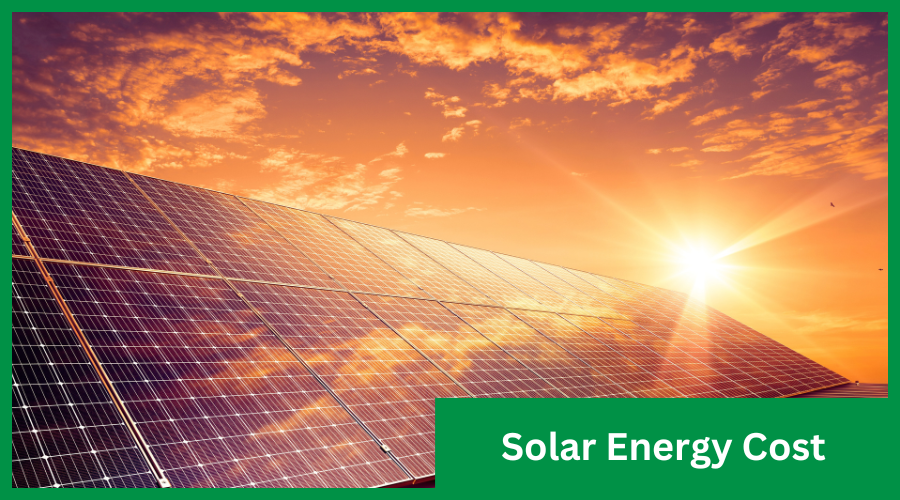
Solar energy cost is one of the most important factors to consider when making the switch to renewable energy. While the upfront investment can seem high, the long-term savings and environmental benefits make solar an attractive option for homeowners and businesses alike. In this guide, we’ll break down all the aspects of solar energy costs, from installation and maintenance to how solar compares with traditional energy sources like fossil fuels. We’ll also cover the variety of incentive programs and rebates available to help offset the initial costs, ensuring that solar energy is affordable and accessible for everyone.
As the cost of solar energy continues to decrease, more people are turning to this renewable resource for energy independence and long-term savings. Whether you're curious about the price of installing solar panels for your home or exploring the financial benefits of a larger solar farm, this comprehensive guide will provide the information you need. By the end of this article, you’ll have a clearer understanding of the costs, benefits, and incentives associated with solar energy, helping you make an informed decision about going solar.
Solar Energy Costs
The cost of solar energy can vary depending on several factors, such as location, system size, energy usage, and local incentives. It's crucial to understand not only the upfront cost but also the long-term savings potential. Solar energy is an investment that can offer significant financial benefits over time. Still, it’s essential to break down the specifics of what you’ll be paying for and how the cost is calculated.
Let’s dive into the common questions regarding the cost of solar energy, including how much it typically costs to install, the price per watt or kilowatt-hour (kWh), and the savings you can expect over time.
What is the Cost of Solar Energy?
The total cost of solar energy involves several components: equipment (such as solar panels and inverters), installation fees, maintenance, and sometimes additional charges like permits. Typically, for residential systems in the U.S., costs can range between $15,000 and $25,000 before applying tax credits or rebates. This wide range depends on the size of the system and location, but incentives such as the federal Investment Tax Credit (ITC) can reduce your total out-of-pocket costs by up to 30%.
It’s important to remember that solar panels are a long-term investment. While the upfront cost may seem high, you will reap substantial financial benefits through reduced or eliminated electricity bills over the next 25-30 years.
On average, solar energy installation costs between $3 and $4 per watt. The total cost will depend on the size of your system, which is measured in kilowatts (kW). For example, a 6kW system — commonly used for a standard home — might cost between $18,000 and $24,000 before incentives. Larger systems, such as those used for businesses, will naturally cost more.
Key cost factors include:
- Location: Areas with more sunlight can generate more energy, which may lead to lower costs per kWh.
- System Size: Larger systems cost more but also produce more electricity.
- Local Incentives: State or local tax credits can reduce costs significantly.
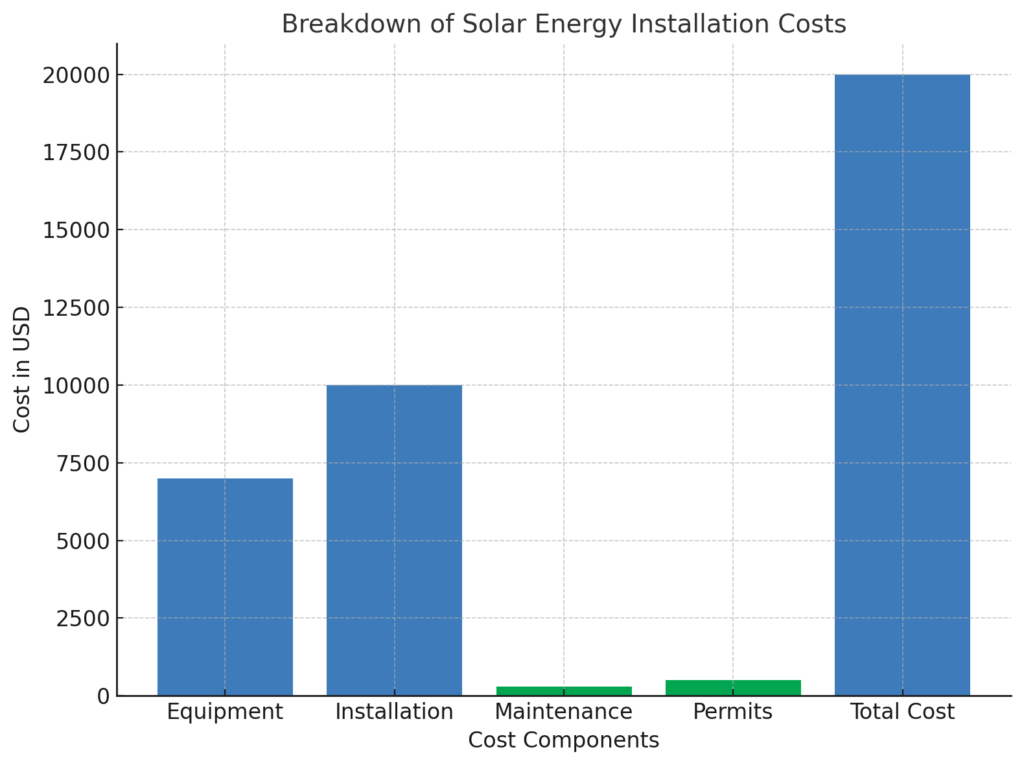
Solar Energy Cost Per Watt
Solar energy systems are priced by the watt, making it a straightforward metric to estimate costs. As of 2024, the national average cost is approximately $3 per watt. This means that for a typical 6kW system, you can expect a starting cost of around $18,000 before incentives. Remember that prices may fluctuate depending on supply chains, technological improvements, and regional markets.
For larger systems, such as those for commercial buildings, the cost per watt might be lower due to economies of scale. Bulk purchases of panels and components can reduce overall costs, but the upfront investment will still be higher due to the system's size.
Cost Per kWh
A key metric for evaluating solar energy affordability is the cost per kilowatt-hour (kWh). After installation, the cost per kWh for solar energy typically ranges from $0.06 to $0.12, depending on your location and how efficient your system is. This is significantly lower than the national average for electricity from traditional sources, which can range from $0.13 to $0.20 per kWh.
- Solar energy systems produce power at a lower cost, and over time, these savings add up.
- Utility prices are expected to rise in the future, making solar energy even more cost-effective in the long run.
By comparing these costs to what you're currently paying for electricity, you can estimate how long it will take to see a return on your investment (usually within 5 to 8 years for most residential systems).
System Costs
The cost of the entire solar energy system includes solar panels, inverters, racking, and installation labor. A typical residential system, ranging from 5kW to 10kW, costs between $15,000 and $30,000 before incentives. The price difference depends on how large your home is and how much energy you need to produce.
Some components that can affect system cost:
- Inverters: Responsible for converting solar energy into usable electricity. Different types of inverters come with other costs.
- Mounting and Racking: Depending on whether your panels are mounted on your roof or the ground, the cost may vary.
- Installation: Labor costs for the installation team can vary significantly depending on your region.
Costs of Solar Energy Over Time
While the upfront cost of solar energy might seem high, it's essential to consider the long-term savings. Solar panels have a lifespan of 25 to 30 years and generally require minimal maintenance. After the initial payback period, which can range from 5 to 8 years, your solar panels will generate free electricity for the rest of their lifespan.
Other long-term benefits include:
- Protection from rising utility rates: With solar panels, you're less dependent on your utility company and protected from future electricity price increases.
- Increased home value: Studies have shown that homes equipped with solar energy systems sell for more, and they tend to sell faster.
- Environmental benefits: Reducing your carbon footprint while saving money over time.
Average Cost Per kWh
When all is said and done, the average cost per kWh for solar energy — after installation and incentives — typically falls between $0.08 and $0.16. This is substantially lower than the average retail cost of electricity from the grid.
Several factors affect this:
- Sunlight Availability: Regions with more direct sunlight may see lower costs.
- System Efficiency: The more efficient your system, the lower your cost per kWh.
- Local Energy Prices: If your utility rates are high, the savings from solar will be even greater.
Installation Costs
Installation costs are a critical component of the total price of solar energy. On average, installation costs can range from $7,000 to $15,000, depending on the size of your system and the complexity of the installation. Factors like roof type, system size, and even local labor rates can influence these costs.
For example:
- A simple roof installation on a single-story home may cost less.
- A complex or multi-level roof may require more labor and higher installation fees.
- Ground-mounted systems may also increase installation costs due to additional equipment.
How Much Can You Save?
When it comes to savings, switching to solar energy can result in significant long-term financial benefits. Over the lifespan of your system, which is typically 25 to 30 years, you could save tens of thousands of dollars on energy costs, depending on your location and energy needs.
Consider these potential savings:
- In areas with high electricity rates, solar energy could reduce your electricity bill by 70% to 100%.
- The average U.S. household can save between $20,000 and $50,000 over the life of a solar energy system.
- Solar panels also hedge against rising utility prices, making the savings more significant as energy prices increase over time.
By carefully evaluating these factors, you can see that solar energy not only reduces your environmental impact but also provides a robust return on investment.
Key Takeaways:
- Cost Range: Solar energy systems typically cost between $15,000 and $30,000 for residential installations before incentives.
- Cost Per Watt: The average cost per watt for solar energy is around $3 to $4.
- Cost Per kWh: After installation, solar energy costs between $0.06 and $0.12 per kWh, which is lower than traditional electricity rates.
- System Components: Costs include panels, inverters, mounting hardware, and labor.
- Installation Costs: Installation fees range from $7,000 to $15,000, depending on system size and complexity.
- Payback Period: Most homeowners see a return on investment within 5 to 8 years.
- Long-Term Savings: Over 25 to 30 years, solar panels can save homeowners between $20,000 and $50,000.
- Additional Benefits: Solar panels protect against rising utility rates, increase home value, and reduce environmental impact.
Solar Energy Costs For Homes
Installing solar panels at home is a popular and effective way to reduce long-term energy costs while increasing your energy independence. Whether you're looking to reduce monthly utility bills or make an environmentally conscious investment, understanding the costs associated with residential solar energy systems is essential. These costs can vary based on several factors, including the size of your system, your location, and your energy needs. Let's take a closer look at the various expenses you might encounter when installing solar panels at home.
Many homeowners are initially concerned with the high upfront costs, but government incentives, tax credits, and financing options can significantly lower out-of-pocket expenses. Additionally, solar systems pay for themselves over time through energy savings. On average, solar panels last 25 to 30 years, meaning they provide decades of savings after the initial payback period, which is typically around 5 to 8 years.
The cost of home solar energy systems varies, but in general, most homeowners can expect to pay between $15,000 and $30,000 for a complete system before applying for federal tax credits and incentives. With the Investment Tax Credit (ITC) offering up to 30% back on installation costs, many homeowners reduce their final price by thousands of dollars.
Factors affecting home solar energy costs include:
- System size: Larger homes require more solar panels, increasing the overall cost.
- Location: Areas with more sunlight are more efficient for solar power, reducing costs over time.
- Energy consumption: Homes with higher electricity usage may require larger systems, raising the upfront cost.
Energy Consumption Patterns
When looking at the cost of solar energy specifically for your home, it’s essential to consider your unique energy consumption patterns. The average household consumes about 900 to 1,000 kWh of electricity per month, and the size of your solar panel system should be based on this demand. A typical 6 kW system, which covers most residential needs, can cost around $18,000 to $24,000 before incentives.
Here's how it breaks down:
- A 3 kW system may cost between $9,000 and $12,000, and it is suitable for smaller homes or those with low energy consumption.
- A more extensive 10 kW system, needed for high-consumption homes, could cost anywhere from $30,000 to $40,000.
It’s helpful to use a solar cost calculator to estimate the specific cost for your home based on factors like your roof size, the amount of sunlight your location receives, and your energy consumption.
Costs of Solar Panels
Solar panels are the most visible component of your solar energy system and one of the largest cost factors. On average, the cost of the panels alone accounts for about 25-30% of the total installation cost. Prices for solar panels vary depending on the type, brand, and efficiency but typically range from $2.50 to $3.50 per watt.
Here’s a comparison of standard solar panel options:
| Panel Type | Cost per Watt | Efficiency | Lifespan |
|---|---|---|---|
| Monocrystalline | $3 - $3.50 | High (18-22%) | 25-30 years |
| Polycrystalline | $2.50 - $3 | Medium (15-17%) | 20-25 years |
| Thin-Film | $2 - $2.50 | Low (10-12%) | 10-15 years |
Monocrystalline panels are the most efficient but also the most expensive. Polycrystalline panels balance cost and efficiency, while thin-film panels are cheaper but less effective and often used in larger installations with more space.
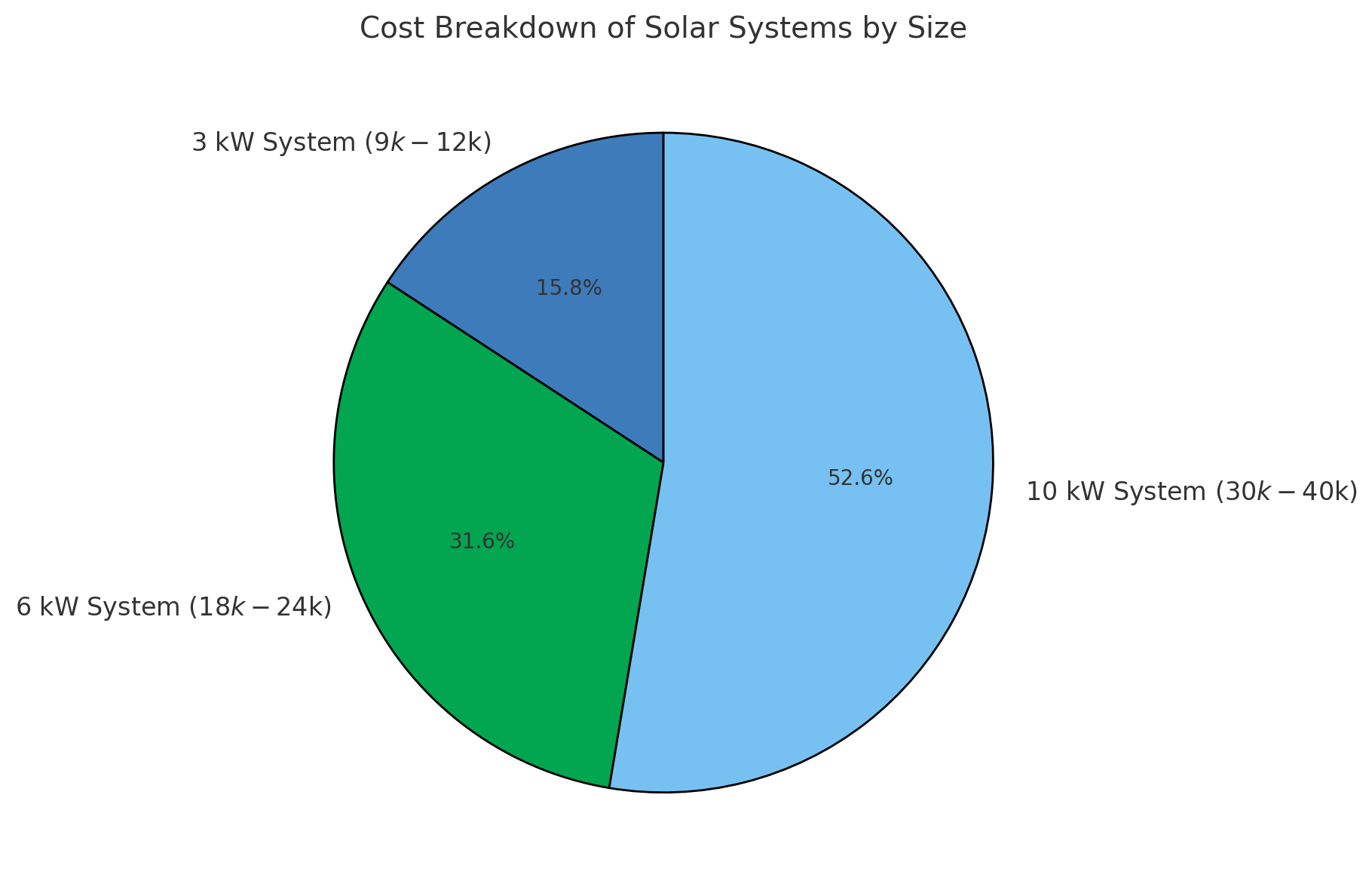
Solar System Price Breakdown
The cost of a complete home solar energy system includes several components beyond just the solar panels themselves. These include:
- Panels: Typically 25-30% of the total cost.
- Inverters: Convert the energy for use in your home.
- Installation: Labor costs, which can vary by region.
- Additional equipment: Like batteries for energy storage or smart home technology.
Here’s a rough breakdown of the costs for a 6kW system:
- Panels: $6,000 to $7,200
- Inverters: $1,000 to $3,000
- Installation: $5,000 to $7,000
- Additional Equipment: $2,000 to $5,000
The total cost might be around $15,000 to $25,000, but federal, state, and local incentives could reduce this amount substantially.
Residential Solar Energy Cost
Residential solar energy systems are specifically designed to meet the energy needs of households. These systems typically range in size from 3kW to 10kW, and the cost will depend on how much energy you need to offset.
Here’s a look at common system sizes and their approximate costs:
- 3kW system: $9,000 - $12,000
- 5kW system: $15,000 - $20,000
- 7kW system: $21,000 - $28,000
- 10kW system: $30,000 - $40,000
Remember, while larger systems have higher upfront costs, they also generate more energy, leading to more significant long-term savings.
How Much Do You Need to Go Solar?
In summary, getting solar energy for your home involves both an upfront investment and the potential for substantial long-term savings. While the average system cost ranges from $15,000 to $30,000, the amount you’ll spend depends on your energy needs, the size of your system, and available incentives.
By factoring in:
- Tax credits: Up to 30% of your costs are covered.
- Utility savings: Significant reductions in your energy bills.
- Environmental benefits: Lower carbon footprint and reduced reliance on fossil fuels.
Switching to solar energy is not only financially viable but also a sustainable choice for the future.
Key Takeaways:
- Home solar systems cost $15,000 to $30,000 before incentives, with size, location, and energy use affecting the price. Federal tax credits can lower costs by 30%. A typical 6kW system costs around $18,000 to $24,000. Most systems pay for themselves in 5 to 8 years, offering long-term savings and environmental benefits.
Installation Costs
When installing a solar energy system, it's essential to understand the various costs involved. These include the price of the equipment, labor, and any additional fees associated with installation. Below, we’ll explore what factors contribute to the installation cost and how they can be reduced.
What to Expect
The total cost of solar installation typically ranges from $15,000 to $30,000 for residential systems. This includes the cost of the panels, inverters, and other hardware, as well as labor. However, the final amount can vary depending on the size of the system, your location, and the complexity of the installation.
How Much Does it Cost to Install Solar Energy?
The cost to install solar energy can be broken down into two main components: equipment and labor. On average, installation costs make up around 30% of the total price. In most cases, the labor and installation costs range from $7,000 to $15,000, depending on system size and roof type. Additional factors such as permits, inspections, and geographic location can influence the total price.
Initial Cost and Ways to Reduce Solar Installation Costs
The initial cost of solar energy includes the purchase of the equipment and the installation fees. Fortunately, there are ways to reduce this cost:
- Incentives and Tax Credits: Federal, state, and local incentives can lower the overall cost by up to 30%.
- Solar Energy Cost Estimators: Using online cost estimators can help you get a more accurate picture of what you’ll pay based on your energy usage and location.
- Cost Reductions Over Time: As solar technology improves, installation costs have dropped significantly over the last decade.
By combining intelligent incentives and understanding local installation conditions, homeowners can drastically reduce the initial cost of solar.
Solar Energy Cost Comparison with Other Energy Sources
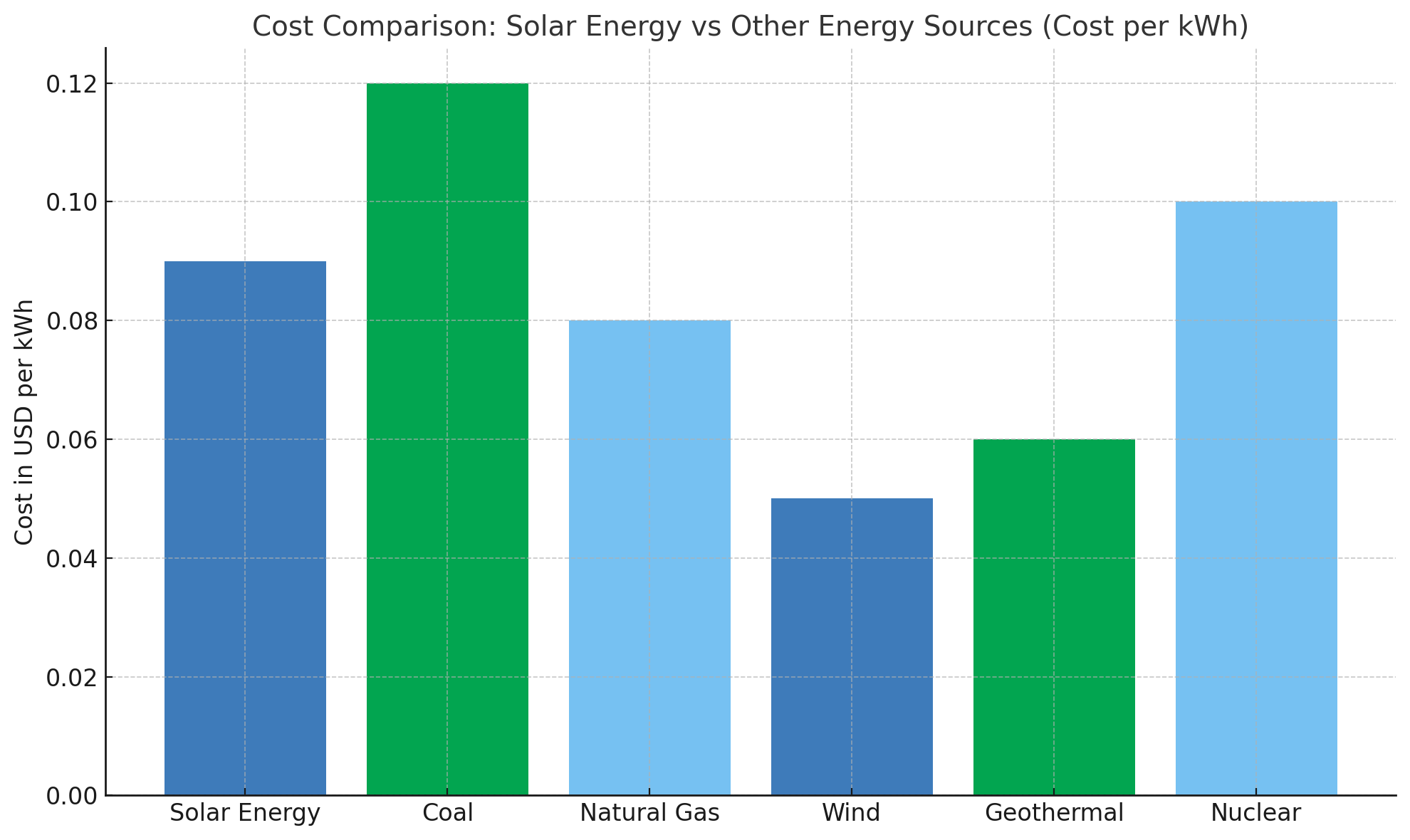
Understanding how solar energy costs compare to other energy sources is key to evaluating its overall value. Solar energy has consistently become more cost-effective, and when compared to traditional fossil fuels, as well as other renewable sources, its long-term savings and environmental benefits stand out. Below, we break down the costs and benefits of solar energy compared to fossil fuels, coal, natural gas, wind, geothermal, and nuclear power.
Solar Energy vs. Fossil Fuels: Trends Over Time
Solar energy has seen significant cost reductions over the past decade, while the cost of fossil fuels like coal and natural gas has remained relatively stable or increased. The average cost of electricity from fossil fuels ranges from $0.05 to $0.17 per kWh, while solar energy, once installed, can deliver electricity at $0.06 to $0.12 per kWh. Furthermore, fossil fuels come with volatile price fluctuations due to market demand, whereas solar energy provides a more stable and predictable cost structure over time.
Solar Energy Cost vs. Coal and Natural Gas
In terms of cost per kWh, solar energy now competes closely with coal and natural gas, particularly as advancements in solar technology have reduced production costs. For example:
- Coal: Costs range from $0.10 to $0.14 per kWh but come with high environmental costs due to carbon emissions.
- Natural Gas: Often slightly cheaper at $0.06 to $0.12 per kWh, but still subject to market price volatility.
- Solar Energy: Currently between $0.06 and $0.12 per kWh, with the added benefit of long-term savings and environmental sustainability.
Solar Energy vs. Wind and Geothermal Energy
When comparing solar energy with other renewable energy sources like wind and geothermal, each has its strengths and ideal applications, but solar often comes out on top for residential and commercial projects due to its scalability and flexibility.
- Wind Energy: Costs range from $0.02 to $0.06 per kWh, making it slightly cheaper than solar, but it is more location-dependent and requires large-scale installations.
- Geothermal Energy: While geothermal energy is highly efficient, it is less common for widespread residential use, with costs ranging from $0.05 to $0.08 per kWh.
Both wind and geothermal energy can offer competitive pricing, but solar remains more accessible for most homeowners and businesses due to ease of installation and the availability of government incentives.
Solar Energy vs. Nuclear Power
Nuclear energy offers a different scale of power generation, often used for large-scale grids rather than individual homes or businesses. However, nuclear power comes with significantly higher upfront costs compared to solar.
- Nuclear Energy: While it can deliver energy at $0.09 to $0.12 per kWh, the cost of building and maintaining nuclear plants is astronomical, often in the billions of dollars.
- Solar Energy: By contrast, solar panel systems for residential or commercial properties are much more affordable, with installation costs ranging from $15,000 to $30,000. The long-term savings also favor solar, as the cost per kWh decreases after the initial payback period.
Cost-Benefit Analysis of Solar Energy
The long-term benefits of solar energy extend beyond financial savings. Solar not only reduces electricity costs but also minimizes environmental impacts, making it a win-win solution for both homeowners and the planet.
Key points in favor of solar energy:
- Marginal Costs: After installation, solar energy has nearly zero marginal costs, as sunlight is free and plentiful.
- Environmental Benefits: Solar energy produces no carbon emissions, reducing your carbon footprint and helping mitigate climate change.
- Long-Term Savings: Over 25 to 30 years, solar energy systems can save homeowners tens of thousands of dollars in energy costs, especially in areas with high electricity rates.
- Energy Independence: Solar provides a level of energy independence from fluctuating fossil fuel prices and grid outages.
By comparing these factors, it’s clear that solar energy offers substantial economic and environmental advantages over both traditional and renewable alternatives.
Key Takeaways:
Solar Energy Maintenance and Other Costs
While solar energy systems are generally low-maintenance, there are still some costs associated with keeping your system running efficiently over its 25 to 30-year lifespan. Understanding these maintenance costs, as well as additional expenses like battery storage and roofing options, is essential for maximizing your system's performance and longevity.
Solar Energy Maintenance Costs
Solar panels are designed to be durable and require minimal upkeep. However, routine maintenance is necessary to ensure maximum efficiency and prevent issues over time. Most homeowners can expect to spend about $100 to $300 per year on maintenance, which may include:
- Cleaning: Dust, dirt, and debris can accumulate on the surface of your solar panels, reducing their efficiency. Cleaning services typically cost between $150 and $400 annually, depending on your location and the size of your system. Alternatively, DIY cleaning is possible with a soft brush and water.
- Inspection: It’s recommended to have your solar panels inspected every few years. Technicians will check for any signs of wear, damage, or potential issues like faulty wiring. Inspections cost around $100 to $150 and can help catch problems before they become costly repairs.
- Repairs: While solar panels rarely require repairs, the inverters, wiring, or mounting hardware might. Repair costs vary based on the issue's complexity but can range from $200 to $1,000 for more significant fixes.
Overall, these maintenance costs are minor compared to the savings generated by solar energy over time.
Solar Energy Battery and Storage Costs
Battery storage systems allow homeowners to store excess energy generated by their solar panels for use during non-sunny hours or grid outages. While battery storage adds flexibility and energy independence, it also increases the overall cost of your solar energy system. The cost of solar batteries typically ranges from $5,000 to $15,000, depending on capacity and brand.
- Battery Costs: Popular options like the Tesla Powerwall or LG Chem range from $7,000 to $10,000 for a single unit. Most residential systems require one to two batteries, depending on your energy usage.
- Storage Benefits: Batteries allow you to store excess solar energy for nighttime use or during power outages, further reducing your reliance on the grid. This can be especially valuable in areas with high electricity prices or frequent outages.
- Long-Term Savings: While the upfront cost is significant, battery storage can increase your long-term savings by providing backup power and enabling you to take full advantage of time-of-use rates, where energy costs fluctuate throughout the day.
Investing in solar storage may be ideal for homeowners who want greater control over their energy usage and costs.
Solar Energy Installation and Roofing Costs
The type of solar installation you choose can significantly impact the overall cost of your system, especially if you opt for innovative solutions like solar shingles or integrated solar roofs. Traditional rooftop panel installations are typically the most cost-effective, but newer technologies like GAF Energy solar roofs or Tesla Solar Roof shingles offer aesthetic and functional benefits at a higher price point.
- Traditional Solar Panels: The standard option for most homeowners, costing between $15,000 and $30,000, depending on the size of the system.
- Solar Shingles: Solar shingles are integrated into your roof, offering a sleeker appearance but at a higher cost. GAF Energy solar shingles, for example, can cost around $25,000 to $45,000, depending on the complexity of your roof and the size of the installation.
- Solar Roofs: Tesla’s Solar Roof is another innovative option, combining solar panels with durable roofing materials. The cost of a Tesla Solar Roof ranges from $35,000 to $70,000, making it one of the most expensive options, but it provides both energy generation and roof replacement in one package.
When deciding on your solar installation, consider the upfront cost and the long-term benefits. While solar shingles and roofs are more expensive, they offer aesthetic advantages and may increase your home’s resale value.
Solar Energy Farm and Environmental Costs
For those interested in large-scale solar projects, such as solar farms, the costs and environmental considerations are more complex. Solar farms can be a lucrative investment, generating energy for entire communities or businesses, but they require significant upfront capital and planning.
- Cost of Solar Farms: Large-scale solar farms typically cost between $500,000 and $2 million per megawatt (MW) of installed capacity. This means that a 5 MW solar farm could cost around $2.5 million to $10 million to build, depending on land acquisition, permits, and installation.
- Environmental Impact: Solar farms offer significant environmental benefits by reducing reliance on fossil fuels and lowering carbon emissions. However, they also require large amounts of land, which can impact local ecosystems. Solar developers often mitigate this by placing solar farms on previously disturbed land or areas with minimal ecological impact.
- Long-Term Profitability: Solar farms provide a steady return on investment through energy sales, often backed by long-term power purchase agreements (PPAs) with utility companies. This makes them a financially viable option for businesses or investors looking for sustainable energy solutions.
The environmental and financial benefits of solar farms make them a strong option for those looking to make a large-scale impact on renewable energy production.
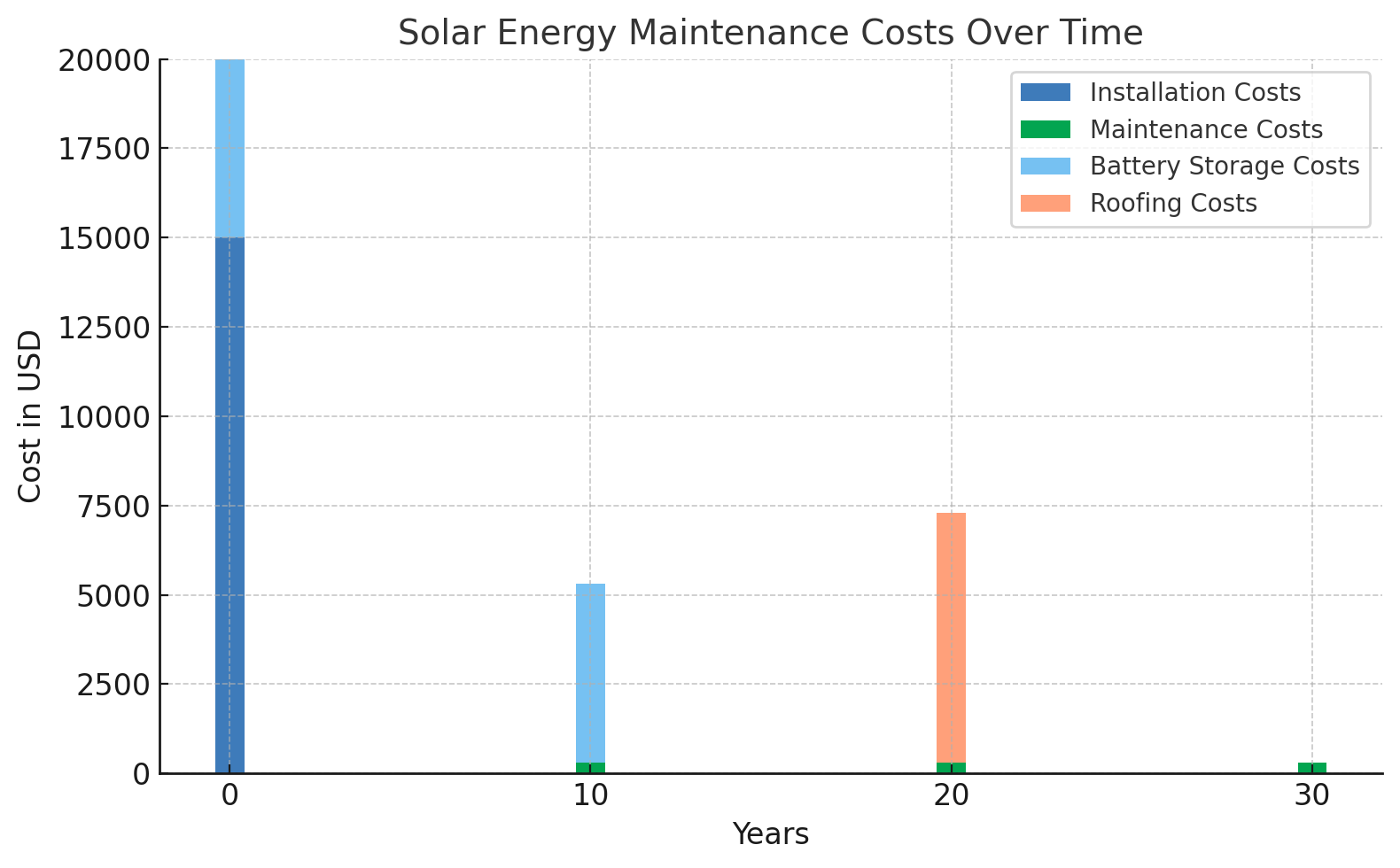
Key Takeaways:
Solar energy maintenance costs are low, around $100 to $300 per year. Batteries, like the Tesla Powerwall, cost $5,000 to $15,000. Traditional solar panels cost $15,000 to $30,000, while solar shingles or Tesla Solar Roofs can reach $70,000. Solar farms cost $500,000 to $2 million per megawatt, offering strong environmental and financial returns.
Solar Energy Programs & Incentives
One of the biggest advantages of switching to solar energy is the variety of programs and incentives available to help offset installation costs. From no-cost solar programs to federal tax credits, homeowners and businesses can take advantage of these initiatives to make solar energy more affordable. Let’s explore some of the top solar programs and incentives available in the U.S.
No-Cost Solar Programs
No-cost solar programs are designed to reduce or eliminate upfront costs for homeowners who want to install solar panels. These programs, often backed by government agencies or utility companies, allow homeowners to install solar panels with little to no out-of-pocket expenses.
- Power Purchase Agreements (PPAs): In a PPA, a solar provider installs the panels at no upfront cost, and the homeowner agrees to purchase the electricity generated by the system at a fixed rate. This rate is typically lower than standard utility rates.
- Leasing Programs: Some companies offer solar panel leases, where you pay a fixed monthly fee for the use of the panels, again with no upfront installation costs. The savings come from lower utility bills and predictable monthly payments.
Several states have pioneered no-cost solar programs, with companies offering attractive financing solutions that cover installation costs, allowing homeowners to enjoy the benefits of solar without the burden of a large initial investment.
State-Specific Solar Incentive Programs
Each state has its own solar incentive programs, with some offering more generous benefits than others. Key states like California, Ohio, Oregon, Washington, and Kentucky provide residents with significant financial incentives to make solar energy more accessible.
- California: As the leader in solar energy adoption, California offers a variety of programs, including the California Solar Initiative (CSI), which provides rebates to homeowners who install solar panels. In addition, net metering policies allow residents to sell excess solar energy back to the grid, further reducing energy costs.
- Ohio: Ohio offers solar incentives through the Energy Loan Fund and Solar Renewable Energy Credits (SRECs), which reward homeowners for generating clean energy.
- Oregon: Residents can take advantage of the Oregon Solar + Storage Rebate Program, which helps reduce the upfront cost of solar and battery systems.
- Washington: Washington’s Renewable Energy System Incentive Program provides financial support for homeowners who install solar energy systems, with bonus payments available for those using locally manufactured components.
- Kentucky: Kentucky offers several incentives, including tax exemptions and rebates for solar installations, making it easier for residents to switch to renewable energy.
By exploring state-specific programs, homeowners can significantly reduce their solar installation costs.
Federal Solar Tax Incentives
At the federal level, the Investment Tax Credit (ITC) is one of the most impactful incentives available to those looking to install solar energy systems. The ITC allows homeowners and businesses to deduct a percentage of the cost of installing a solar energy system from their federal taxes.
- Investment Tax Credit (ITC): Currently set at 30%, the ITC significantly reduces the overall cost of solar installations. For example, if you install a solar system that costs $20,000, you can receive a tax credit of $6,000, bringing the effective cost down to $14,000. This credit applies to both residential and commercial solar systems.
- Eligibility: To qualify, your solar system must be installed by the end of the year, and you must own the system (i.e., not under a lease or PPA). The credit is available for both new installations and major system upgrades.
The ITC is a powerful tool for lowering the cost of solar, making it a key incentive for homeowners and businesses nationwide.
Solar Rebates and Grants
In addition to tax credits and state-specific incentives, many homeowners and businesses can take advantage of solar rebates and grants to further lower the cost of their solar energy systems. These programs vary widely by location but offer direct financial support to make solar energy more affordable.
- Local Utility Rebates: Many utility companies offer rebates for solar installations. For example, some utilities in Texas and Arizona provide rebates ranging from $1,000 to $5,000 for residential solar installations, helping to reduce the overall cost.
- Grants for Commercial Installations: Businesses can benefit from programs like the Rural Energy for America Program (REAP), which provides grants and loan guarantees for installing renewable energy systems, including solar.
- State-Specific Solar Rebates: States like New York, Massachusetts, and Illinois have rebate programs that provide cash incentives for solar installations, sometimes reducing costs by as much as 20-25%.
Rebates and grants, along with federal tax credits, make solar energy more accessible and affordable for both residential and commercial customers.
Key Takeaways:
- No-Cost Solar: Programs like PPAs and leases allow solar installation with no upfront costs.
- State Incentives: States like California, Ohio, and Oregon offer rebates, credits, and financial support to reduce solar costs.
- Federal Tax Credit: The 30% Investment Tax Credit (ITC) can significantly lower solar installation costs.
- Rebates and Grants: Many states and utilities offer rebates and grants, reducing costs by up to 20-25%.
Frequently Asked Questions
The total cost of solar energy includes the price of solar panels, inverters, installation, and any additional fees like permits or maintenance. On average, residential solar energy systems in the U.S. cost between $15,000 and $30,000 before applying federal tax credits and incentives.
Conclusion
In conclusion, while the initial solar energy cost may seem high, the long-term benefits far outweigh the upfront investment. Solar energy not only provides significant savings on electricity bills but also contributes to a cleaner, more sustainable future. With the availability of federal tax credits, state-specific incentives, and rebate programs, the cost of solar can be reduced dramatically, making it a viable option for homeowners and businesses. Furthermore, comparing solar energy with traditional fossil fuels and other renewable sources highlights its growing economic and environmental advantages.
As technology continues to evolve and more incentives are introduced, the affordability and accessibility of solar energy will only increase. Whether installing a small residential system or a large solar farm, the potential savings, combined with environmental benefits, make solar an innovative and future-proof investment. Considering the insights and options outlined in this guide, you can confidently take the following steps toward energy independence and long-term financial savings with solar power.

